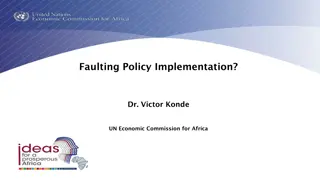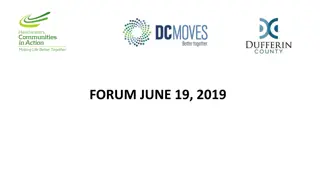
Implications for Irish Development Policy
Explore the implications for Irish economic development policy based on business demography data from 2006 to 2014, including trends in enterprise births and deaths, regional stock changes, and the distribution of high-tech and knowledge-intensive firms across regions.
Download Presentation

Please find below an Image/Link to download the presentation.
The content on the website is provided AS IS for your information and personal use only. It may not be sold, licensed, or shared on other websites without obtaining consent from the author. If you encounter any issues during the download, it is possible that the publisher has removed the file from their server.
You are allowed to download the files provided on this website for personal or commercial use, subject to the condition that they are used lawfully. All files are the property of their respective owners.
The content on the website is provided AS IS for your information and personal use only. It may not be sold, licensed, or shared on other websites without obtaining consent from the author.
E N D
Presentation Transcript
The stock of Irish businesses: Implications for Irish development policy Dr. Dr. Bernadette Power, Bernadette Power, School of Economics, School of Economics, Cork University Business School. Cork University Business School. Rethinking Irish Economic Development 3rd November 2017
Agenda Business Demography Data Key Trends Policy Implications I Case Evidence Policy Implications II & III
Irelands Business Demography Data 2006- 2014 Business Demography Data Active Enterprise Enterprise Births Enterprises Deaths Business Demography Statistics, Central Statistics Office
Enterprise Births & Deaths Relative to Active Firms 14 13 Birth Rate Death Rate 12 11 10 % 9 8 7 6 2006 2008 2010 2012 2014
% Change in Stock of Active Enterprises by Region relative to 2008 14 Border 12 Dublin 10 Mid-East 8 Midland 6 4 Mid-West 2 South- East South- West West 0 -2 -4 2009 2010 2011 2012 2013 2014
The Stock of Businesses % Change (2008-2014)
Hi Tech Manufacturing & Knowledge Intensive Firms 2014 Low Tech Manuf - 1.8% Medium Low Tech Manuf - 1.6% High Medium Tech Manuf - 0.4% High Tech Manuf - 0.1% Other, 32.4 KIS, 28.7 Knowledge intensive services 2008 90,072 (24.5) 2014 108,481 (28.7 ) Low KIS, 34.9
Regional Dist. of Manufacturing & KIS Firms 2014 Border DublinMid Mid- land Mid West 41.1 South East 39.7 South West 37.7 45.4 West East Other Low Knowledge IS Knowledge IS Low Tech Medium Low Tech High Medium Tech High Tech 44.0 12.8 29.4 44.1 33.2 40.6 36.7 31.8 18.7 44.9 29.6 19.4 1.9 1.6 31.8 21.9 1.6 33.6 22.2 2.1 33.1 30.3 25.8 20.9 1.7 2.0 1.9 1.6 1.8 0.9 1.8 2.1 1.9 2.2 1.8 1.5 0.3 0.1 0.3 0.2 0.4 0.2 0.3 0.1 0.4 0.1 0.4 0.1 0.4 0.2 0.3 0.1
Regional Dist. of Manufacturing & KIS Firms 2014 Border DublinMid Mid- land Mid West 41.1 South East 39.7 South West 37.7 45.4 West East Other Low Knowledge IS Knowledge IS Low Tech Medium Low Tech High Medium Tech High Tech 44.0 12.8 29.4 44.1 33.2 40.6 36.7 31.8 18.7 44.9 29.6 19.4 1.9 1.6 31.8 21.9 1.6 33.6 22.2 2.1 33.1 30.3 25.8 20.9 1.7 2.0 1.9 1.6 1.8 0.9 1.8 2.1 1.9 2.2 1.8 1.5 0.3 0.1 0.3 0.2 0.4 0.2 0.3 0.1 0.4 0.1 0.4 0.1 0.4 0.2 0.3 0.1
Regional Dist. of Manufacturing & KIS Firms 2014 Border DublinMid Mid- land Mid West 41.1 South East 39.7 South West 37.7 45.4 West East Other Low Knowledge IS Knowledge IS Low Tech Medium Low Tech High Medium Tech High Tech 44.0 12.8 29.4 44.1 33.2 40.6 36.7 31.8 18.7 44.9 29.6 19.4 1.9 1.6 31.8 21.9 1.6 33.6 22.2 2.1 33.1 30.3 25.8 20.9 1.7 2.0 1.9 1.6 1.8 0.9 1.8 2.1 1.9 2.2 1.8 1.5 0.3 0.1 0.3 0.2 0.4 0.2 0.3 0.1 0.4 0.1 0.4 0.1 0.4 0.2 0.3 0.1
Implications for Enterprise Policy Leverage core strengths Address regional imbalances Manufacturing Regionally dispersed Regional job opportunities. Transition to more high end manufacturing sectors.
SizeDistribution 90.0 80.0 zero employees 70.0 60.0 1-4 employees 50.0 5-9 employees 40.0 30.0 10-49 employees 20.0 50+ employees 10.0 0.0 Active Enterprises 2014 Enterprise Births 2014 Enterprise Deaths 2013 Growth is only occurring in approximately 10% or less of enterprises between 2008 and 2014.
Case Evidence: Firm Survival Attributes which foster survival & offer greater resistance to economic shocks Larger businesses Older businesses Firms operating in concentrated markets. Firms operating in knowledge intensive services. Firms located in rural regions. Failure risks of firms fall considerably if they have scale At least 5+ employees
Implications for Enterprise Policy Only 10% or less firms growing in size Focus on scaling businesses
Case Evidence: Entrepreneurship, Firm Survival and Agglomeration Economies Entrepreneurship Greater population density raises regional births rates Firm Exits Specialisation lowers regional deaths rates.
Implications for Policy Developing other key urban centres Local knowledge is key - bottom up approach to development. Leverage strengths of the region
Thank you for Listening Any Questions? Contact Details Contact Details: : ? ? Dr. Bernadette Power: b.power@ucc.ie






















